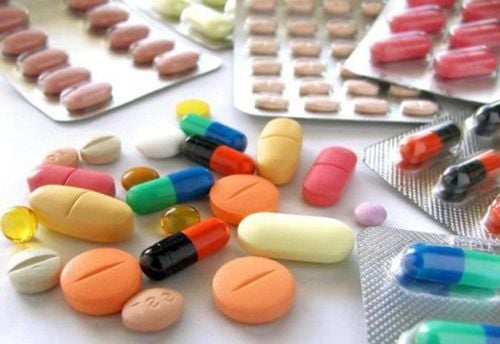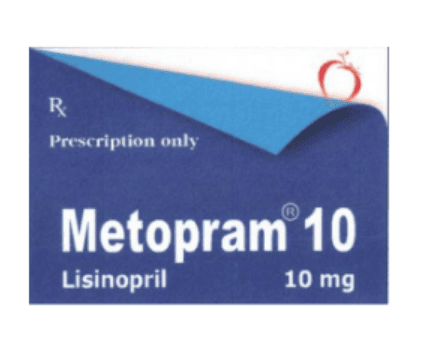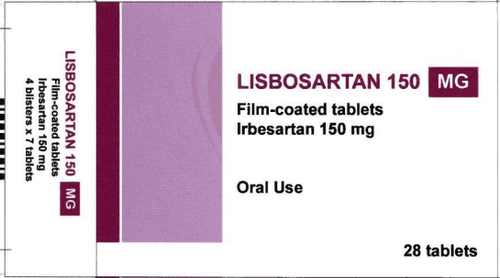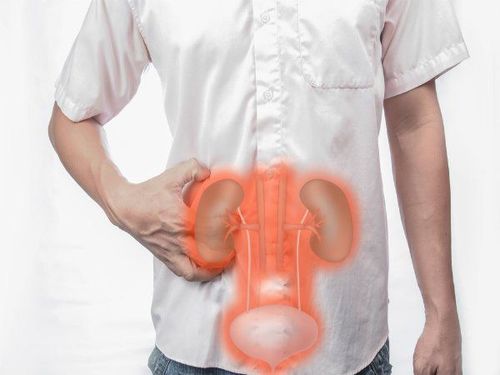This is an automatically translated article.
Agimstan is an Agiotensin II receptor blocker, used in the treatment of hypertension. Agimstan can be used alone or in combination with other drugs during treatment.
1. What is Agimstan 40mg?
Agimstan has the main active ingredient is Telmisartan, the drug is made in the form of tablets with a strength of 40mg.
In the Renin - Angiotensin - Aldosteron system, Angiotensin I under the catalysis of Angiotensin converting enzyme (ACE) forms Angiotensin II. This is a vasoconstrictor, stimulates the adrenal cortex to synthesize and release aldosterone, stimulates the heart. Aldosterone increases potassium excretion and decreases renal sodium excretion. Telmisartan is a specific antagonist of Angiotensin II receptor (type AT1) in vascular smooth muscle and adrenal gland, it prevents binding of Angiotensin II to this receptor causing vasodilation and reducing the effect of Aldosterone. Angiotensin II receptor blockers do not inhibit the breakdown of Bradykinin, so they do not cause a persistent dry cough, a common side effect of angiotensin-converting enzyme inhibitors. Telmisartan is indicated for patients who have stopped taking an angiotensin-converting enzyme inhibitor because of cough.
In humans, a dose of 80 mg Telmisartan almost completely inhibits the antihypertensive effect of Angiotensin II. Doses of Telmisartan above 80 mg/day (up to 160 mg/day) did not increase the therapeutic effect of telmisartan. The antihypertensive effect of Telmisartan is maintained for 24 hours and may persist for up to 48 hours after oral administration.
The antihypertensive effect is gradually apparent over 3 hours after taking the first dose. Usually, the maximum reduction in arterial blood pressure is achieved 4 to 8 weeks after initiation of treatment. Telmisartan reduces both systolic and diastolic blood pressure without altering heart rate.
Similar to angiotensin receptor blockers, telmisartan is effective in reducing the rate of progression of nephropathy and microalbuminuria in patients with diabetes. Telmisartan is recommended for use in this group of patients.
Telmisartan is used in the treatment of congestive heart failure. However, like angiotensin II receptor blockers, they should only be used in patients who cannot tolerate angiotensin-converting enzyme inhibitors (eg, patients with cough or angioedema).
2. Indications and contraindications for taking Agimstan
2.1 Indications Indications for use of Agimstan 40mg in the following cases:
Hypertension: Agimstan is used alone or in combination with other antihypertensive drugs. Agimstan 40mg is used to replace ACE inhibitors in the treatment of heart failure or diabetic kidney disease. 2.2 Contraindications Agimstan 40 mg is contraindicated in the following cases:
Allergy or hypersensitivity to Telmisartan or any of its ingredients. Pregnant women Women who are breastfeeding. Severe renal failure: serum creatinine ≥ 250 micromol/liter or blood potassium ≥ 5 mmol/liter or creatinine clearance ≤ 30 ml/min. Severe liver failure. Congestion. Concomitant use with aliskiren-containing products is contraindicated in patients with diabetes mellitus or renal impairment (GFR < 60 ml/min/1.73 m2).
3. How to take Agimstan 40mg
Agimstan is used orally, once a day. The drug can be taken with or without meals because food only slightly reduces the bioavailability of the drug.
3.1 Drug Dosage Treatment of Hypertension When starting treatment with Agimstan alone, adjust the dose after 1 month or less in high-risk patients such as grade 2 hypertension. When blood pressure is not controlled It may take several months for blood pressure to be controlled at the initial dose and for side effects to be avoided.
Monotherapy: 40mg (1 tablet)/time/day. If no response, can be increased every 4 weeks to a maximum dose of 80mg (2 tablets)/time/day. Combination with other drugs: If there is no response to monotherapy with telmisartan, it can be combined with a thiazide diuretic such as hydrochlorothiazide, the combination of the two should be used. Patients with renal impairment Mild to moderate renal impairment: No dose adjustment is required. Severe renal impairment: Agimstan 40mg is contraindicated because the starting dose of Telmisartan in this subject is 20mg. Glomerular filtration rate < 30ml/min: Contraindicated in combination with Thiazide diuretics. Hepatic impairment: Mild or moderate hepatic impairment, patients with biliary obstruction: the daily dose should not exceed 40 mg/time/day for monotherapy. Severe hepatic impairment: Contraindicated in combination with thiazide diuretics. Elderly: No dose adjustment is required. Children under 18 years of age: safety and effectiveness have not been established, so Agimstan should not be used in this population. 3.2 Overdose of Agimstan 40mg and management Symptoms appear when overdosing Agimstan such as excessive hypotension, slow or fast heart rate, dizziness, lightheadedness.
Treatment of drug overdose Agimstan is mainly symptomatic and supportive.
4. Some possible side effects when using Agimstan 40mg
Adverse effects when using Agimstan are uncommon, usually mild and transient, rarely requiring discontinuation of the drug.
Whole body: fatigue, headache, edema of limbs, angioedema, excessive sweating. Cardiovascular: tachycardia, excessive drop in blood pressure or syncope (common in patients with hypovolemia or salt deficiency, diuretic use, especially in standing position). Central nervous system: agitation, anxiety, dizziness, especially in dehydrated patients (eg, patients receiving high doses of diuretics). Eyes: blurred vision, visual disturbances. Gastrointestinal: dry mouth, loss of appetite, nausea, reflux, abdominal pain, dyspepsia, flatulence, diarrhea. Gastrointestinal bleeding is rare. Urinary: decreased kidney function, increased blood creatinine and urea, urinary tract infections. Respiratory: upper respiratory tract infection, flu-like symptoms (nasal congestion, runny nose, sneezing, sore throat, cough, earache, fever). Metabolic: hyperkalemia, increased uric acid and blood cholesterol. Bones - joints: back pain, muscle pain, may have symptoms like tendonitis.
5. Notes when using Agimstan 40mg
Agimstan should be used with caution in the following cases:
Aortic valve stenosis, mitral stenosis. Obstructive hypertrophic cardiomyopathy. Severe congestive heart failure. Renal artery stenosis. Elderly patients, renal failure: need to monitor blood potassium levels during treatment. It is necessary to reduce the starting dose in some cases. Active peptic ulcer, other gastrointestinal disease (due to risk of gastrointestinal bleeding). Mild and moderate liver failure, requiring close monitoring. Caution should be exercised in patients with biliary obstruction because the drug is excreted in the bile and cleared by the liver. Dehydration (hypovolemia and hyponatremia due to vomiting, diarrhea, prolonged use of diuretics, dialysis, dietary salt restriction) increases the risk of excessive hypotension. Correct dehydration before administering telmisartan or reduce the dose and monitor the patient during treatment. Increasing the dose of telmisartan in the presence of transient hypotension is not contraindicated, but therapy should be closely monitored after blood pressure has stabilized (e.g. volume expansion). History of angioedema with or without an ACE inhibitor or Angiotensin II receptor blocker. Telmisartan can interfere with porphyrin metabolism, use only when there is no other safer alternative. Agimstan should be used with caution in driving and operating machinery because it can cause dizziness and lightheadedness due to hypotension. Pregnancy: Agimstan is contraindicated in pregnant women. If you intend to become pregnant, you should replace it with another drug before becoming pregnant. Using telmisartan after the third month of pregnancy, the drug may act directly on the renin-angiotensin system, causing harm to the fetus such as hypotension, reversible renal failure, anuria, bone hypoplasia neonatal skull, causing fetal or neonatal death. Low amniotic fluid during pregnancy possibly due to decreased fetal renal function, combined with spasticity, craniofacial deformity and hypoplastic lung has been reported. Discontinue Telmisartan as soon as possible when pregnancy is detected. Lactation: Agimstan is contraindicated because it is not known whether the drug is excreted in breast milk. To ensure the safety of breastfeeding, consideration should be given to discontinuing nursing or discontinuing the drug depending on the importance of the drug to the mother.
6. Drug interactions
Telmisartan is not metabolized by cytochrome P450, cytochrome P450 inhibitors or inducers have virtually no pharmacokinetic interactions. Telmisartan does not inhibit CYP isoenzymes except CYP2C19.
Digoxin: Telmisartan increases the serum concentration of digoxin when administered concomitantly. During treatment, it is necessary to monitor the concentration of Digoxin in the blood, adjust the dose and stop taking Telmisartan to avoid an overdose of Digoxin.
Warfarin: Telmisartan slightly decreased the blood concentration of Warfarin when administered concurrently for 10 days, but did not change the INR.
Diuretics: Concomitant use increases the antihypertensive effect of telmisartan.
Potassium-sparing diuretics: may increase the hyperkalemic effect of telmisartan.
Nonsteroid anti-inflammatory drugs used concurrently with telmisartan, especially COX-2 can cause disorders or impairment of renal function. Monitor renal function in this case.
Acetaminophen, Gluburide, Amlodipine, Ibuprofen, Simvastatin: almost no pharmacokinetic interaction.
Corticosteroids (systemic route): reduce the antihypertensive effect of Agimstan.
Please dial HOTLINE for more information or register for an appointment HERE. Download MyVinmec app to make appointments faster and to manage your bookings easily.













